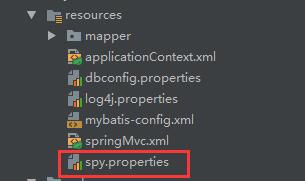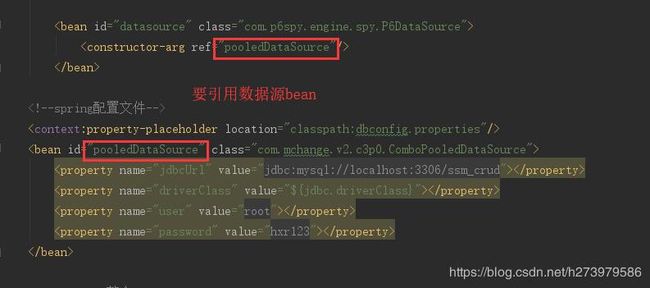配置p6spy打印完整sql语句
在项目中我们经常遇到控制台输出sql语句带有“?”例如:INSERT INTO tb_user ( name ) VALUES ( ? )
这种情况非常影响我们调试程序,做为程序猿的我们是绝对不允许的。
引用p6spy解决这个问题。
- 首先去maven下载p6spy的Jar包
<dependency>
<groupId>p6spygroupId>
<artifactId>p6spyartifactId>
<version>最新版本version>
dependency>
#################################################################
# P6Spy Options File #
# See documentation for detailed instructions #
# http://p6spy.github.io/p6spy/2.0/configandusage.html #
#################################################################
#################################################################
# MODULES #
# #
# Module list adapts the modular functionality of P6Spy. #
# Only modules listed are active. #
# (default is com.p6spy.engine.logging.P6LogFactory and #
# com.p6spy.engine.spy.P6SpyFactory) #
# Please note that the core module (P6SpyFactory) can't be #
# deactivated. #
# Unlike the other properties, activation of the changes on #
# this one requires reload. #
#################################################################
#modulelist=com.p6spy.engine.spy.P6SpyFactory,com.p6spy.engine.logging.P6LogFactory,com.p6spy.engine.outage.P6OutageFactory
################################################################
# CORE (P6SPY) PROPERTIES #
################################################################
# A comma separated list of JDBC drivers to load and register.
# (default is empty)
#
# Note: This is normally only needed when using P6Spy in an
# application server environment with a JNDI data source or when
# using a JDBC driver that does not implement the JDBC 4.0 API
# (specifically automatic registration).
driverlist=com.mysql.jdbc.Driver
# for flushing per statement
# (default is false)
#autoflush = false
# sets the date format using Java's SimpleDateFormat routine.
# In case property is not set, miliseconds since 1.1.1970 (unix time) is used (default is empty)
dateformat=yyyy-MM-dd HH:mm:ss
# prints a stack trace for every statement logged
#stacktrace=false
# if stacktrace=true, specifies the stack trace to print
#stacktraceclass=
# determines if property file should be reloaded
# Please note: reload means forgetting all the previously set
# settings (even those set during runtime - via JMX)
# and starting with the clean table
# (default is false)
#reloadproperties=false
# determines how often should be reloaded in seconds
# (default is 60)
#reloadpropertiesinterval=60
# specifies the appender to use for logging
# Please note: reload means forgetting all the previously set
# settings (even those set during runtime - via JMX)
# and starting with the clean table
# (only the properties read from the configuration file)
# (default is com.p6spy.engine.spy.appender.FileLogger)
#appender=com.p6spy.engine.spy.appender.Slf4JLogger
#appender=com.p6spy.engine.spy.appender.StdoutLogger
#appender=com.p6spy.engine.spy.appender.FileLogger
#自定义的SQL格式化输出
appender=com.p6spy.engine.spy.appender.StdoutLogger
# name of logfile to use, note Windows users should make sure to use forward slashes in their pathname (e:/test/spy.log)
# (used for com.p6spy.engine.spy.appender.FileLogger only)
# (default is spy.log)
#logfile = spy.log
# append to the p6spy log file. if this is set to false the
# log file is truncated every time. (file logger only)
# (default is true)
#append=true
# class to use for formatting log messages (default is: com.p6spy.engine.spy.appender.SingleLineFormat)
logMessageFormat=com.p6spy.engine.spy.appender.SingleLineFormat
#logMessageFormat=com.p6spy.engine.spy.appender.MultiLineFormat
# format that is used for logging of the date/time/... (has to be compatible with java.text.SimpleDateFormat)
# (default is dd-MMM-yy)
databaseDialectDateFormat=yyyy-MM-dd HH:mm:ss
# whether to expose options via JMX or not
# (default is true)
#jmx=true
# if exposing options via jmx (see option: jmx), what should be the prefix used?
# jmx naming pattern constructed is: com.p6spy(.<jmxPrefix>)?:name=<optionsClassName>
# please note, if there is already such a name in use it would be unregistered first (the last registered wins)
# (default is none)
#jmxPrefix=
# if set to true, the execution time will be measured in nanoseconds as opposed to milliseconds
# (default is false)
#useNanoTime=false
#################################################################
# DataSource replacement #
# #
# Replace the real DataSource class in your application server #
# configuration with the name com.p6spy.engine.spy.P6DataSource #
# (that provides also connection pooling and xa support). #
# then add the JNDI name and class name of the real #
# DataSource here #
# #
# Values set in this item cannot be reloaded using the #
# reloadproperties variable. Once it is loaded, it remains #
# in memory until the application is restarted. #
# #
#################################################################
#realdatasource=/RealMySqlDS
#realdatasourceclass=com.mysql.jdbc.jdbc2.optional.MysqlDataSource
#################################################################
# DataSource properties #
# #
# If you are using the DataSource support to intercept calls #
# to a DataSource that requires properties for proper setup, #
# define those properties here. Use name value pairs, separate #
# the name and value with a semicolon, and separate the #
# pairs with commas. #
# #
# The example shown here is for mysql #
# #
#################################################################
#realdatasourceproperties=port;3306,serverName;myhost,databaseName;jbossdb,foo;bar
#################################################################
# JNDI DataSource lookup #
# #
# If you are using the DataSource support outside of an app #
# server, you will probably need to define the JNDI Context #
# environment. #
# #
# If the P6Spy code will be executing inside an app server then #
# do not use these properties, and the DataSource lookup will #
# use the naming context defined by the app server. #
# #
# The two standard elements of the naming environment are #
# jndicontextfactory and jndicontextproviderurl. If you need #
# additional elements, use the jndicontextcustom property. #
# You can define multiple properties in jndicontextcustom, #
# in name value pairs. Separate the name and value with a #
# semicolon, and separate the pairs with commas. #
# #
# The example shown here is for a standalone program running on #
# a machine that is also running JBoss, so the JDNI context #
# is configured for JBoss (3.0.4). #
# #
# (by default all these are empty) #
#################################################################
#jndicontextfactory=org.jnp.interfaces.NamingContextFactory
#jndicontextproviderurl=localhost:1099
#jndicontextcustom=java.naming.factory.url.pkgs;org.jboss.nameing:org.jnp.interfaces
#jndicontextfactory=com.ibm.websphere.naming.WsnInitialContextFactory
#jndicontextproviderurl=iiop://localhost:900
################################################################
# P6 LOGGING SPECIFIC PROPERTIES #
################################################################
# filter what is logged
# please note this is a precondition for usage of: include/exclude/sqlexpression
# (default is false)
#filter=false
# comma separated list of strings to include
# please note that special characters escaping (used in java) has to be done for the provided regular expression
# (default is empty)
#include =
# comma separated list of strings to exclude
# (default is empty)
#exclude =
# sql expression to evaluate if using regex
# please note that special characters escaping (used in java) has to be done for the provided regular expression
# (default is empty)
#sqlexpression =
#list of categories to exclude: error, info, batch, debug, statement,
#commit, rollback and result are valid values
# (default is info,debug,result,resultset,batch)
#excludecategories=info,debug,result,resultset,batch
# Execution threshold applies to the standard logging of P6Spy.
# While the standard logging logs out every statement
# regardless of its execution time, this feature puts a time
# condition on that logging. Only statements that have taken
# longer than the time specified (in milliseconds) will be
# logged. This way it is possible to see only statements that
# have exceeded some high water mark.
# This time is reloadable.
#
# executionThreshold=integer time (milliseconds)
# (default is 0)
#executionThreshold=
################################################################
# P6 OUTAGE SPECIFIC PROPERTIES #
################################################################
# Outage Detection
#
# This feature detects long-running statements that may be indicative of
# a database outage problem. If this feature is turned on, it will log any
# statement that surpasses the configurable time boundary during its execution.
# When this feature is enabled, no other statements are logged except the long
# running statements. The interval property is the boundary time set in seconds.
# For example, if this is set to 2, then any statement requiring at least 2
# seconds will be logged. Note that the same statement will continue to be logged
# for as long as it executes. So if the interval is set to 2, and the query takes
# 11 seconds, it will be logged 5 times (at the 2, 4, 6, 8, 10 second intervals).
#
# outagedetection=true|false
# outagedetectioninterval=integer time (seconds)
#
# (default is false)
#outagedetection=false
# (default is 60)
#outagedetectioninterval=30
- 配置spring数据源
<bean id="datasource" class="com.p6spy.engine.spy.P6DataSource">
<constructor-arg ref="pooledDataSource"/>
bean>
- 修改连接驱动
#jdbc.jdbcUrl=jdbc:mysql://localhost:3306/test 以前连接配置
jdbc.jdbcUrl=jdbc:p6spy:mysql://localhost:3306/test p6spy连接配置
#jdbc.driverClass=com.mysql.jdbc.Driver 以前驱动配置
jdbc.driverClass=com.p6spy.engine.spy.P6SpyDriver p6spy驱动配置
jdbc.user=root
jdbc.password=root
在控制台就可以显示我们需要sql的语句了
深入了解
在spy.properties配置文件中有个logMessageFormat=com.p6spy.engine.spy.appender.SingleLineFormat 我们可以点进去看看SingleLineFormat这个类,该方法如下:
public class SingleLineFormat implements MessageFormattingStrategy {
public SingleLineFormat() {
}
public String formatMessage(int connectionId, String now, long elapsed, String category, String prepared, String sql, String url) {
return now + "|" + elapsed + "|" + category + "|connection " + connectionId + "|url " + url + "|" + P6Util.singleLine(prepared) + "|" + P6Util.singleLine(sql);
}
}
prepared这个参数是带?号的sql语句,sql这个参数是我们想要的sql语句

